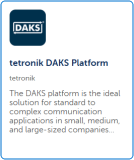© tetronik GmbH. All rights reserved.
© tetronik GmbH. All rights reserved.
DAKS® + Mitel
As a global communications solutions provider, Mitel offers solutions for business communications, unified communications (UC), contact centers, cloud telephony, collaboration tools and crisis and emergency management. Mitel addresses companies and organizations of all sizes and industries with a special focus on vertical markets.
The Mitel solution portfolio includes tetronik products as solution components for alerting, crisis and emergency management – both in its own marketing (under the product name 'OpenScape Alarm Response') and with DAKS® in the Mitel MTN program.
A successful highlight is the joint solution as a certified personal emergency signal system in accordance with DGUV Rule 112-139.
tetronik product portfolio with the partner
OpenScape Alarm Response ("OScAR")
OpenScape Alarm Response is an OEM product from tetronik GmbH for Mitel based on DAKS. OpenScape Alarm Response (or "OScAR" for short) is offered by Mitel in two performance variants (OScAR-Pro and OScAR-Eco) in their 'Mission Critical and Vertical Solutions' portfolio.
DAKS® within the Mitel Technology Network (MTN)
In addition, DAKS® is listed in the Mitel Apps & Integrations Gallery as a third-party solution from tetronik GmbH. The 'Mitel Compatible' certification status confirms global interoperability with Mitel products and supportability by Mitel. DAKS integrates into all topologies of the Mitel ITC infrastructure for messaging and voice communication.
Integration and system support
Mitel PBX
Certified Voice-over-IP interface for voice alarms in the form of announcements
The DAKS server connection uses the SIP protocol, which supports the following features in addition to the basic call functionality:
- Calling Name/Connected Name
- Calling Number/Connected Number
- Acceptance of keystrokes as RTP info (according to RFC2833)
Mitel OpenScape PBX
Certified Voice-over-IP interface for voice alarms in the form of announcements
The DAKS server connection uses the SIP-Q protocol, which supports the following features in addition to the basic call functionality:
- Alarm call signaling
- Call waiting (call offer)
- Switching on
- Emergency disconnection
- Forced disconnection
- Emergency disconnection on connection paths
- Forced disconnection from connection paths
- Ignore call pickup group
- Ignore call forwarding
- Breaking do-not-disturb
- Bypassing the executive-secretary facility
- Direct addressing
- Multi-line display messages (server mode)
- Calling Name/Connected Name
- Connected Number
- Acceptance of keystrokes as RTP info (according to RFC2833) or keypad
- Path Replacement
Mitel SIP-DECT
Certified Voice-over-IP interface for voice alarms in the form of announcements
To connect the DAKS server to the SIP DECT system, the Open Mobility Application XML Interface protocol (OM-AXI) is used.
The OM-AXI data interface supports the following functions:
- Text messaging
- with five different ring tones that can be individually configured via VCON
- with output of alarm texts in different colors
- with up to 3 softkeys (read, answer/reject and call setup)
- with call setup to the ESPA4.4.4, TAP or ESPA-X initiator, or to a conference
- Alarm triggering
- initiated by up to 50 different end devices
- with device-specific activation of a broadcast group (independent of the alarm type, e.g. red-button, man-down)
- with device-specific alarm text
- If the data connection to the OM-AXI server fails:
- fallback to telephone alerting
- In the event of OM-AXI base station failure (can be administered):
- monitoring of the OM-AXI base station and alarm triggering in the event of OM-AXI base station failure (can be administered)
- history function (locally at the end device)
Mitel OpenScape SIP-DECT
Certified AML interface (MQTT interface) for messaging
The AML API interface (MQTT interface) is used to connect the DAKS server to the SIP-DECT system.
The AML data interface supports the following functions:
- Send/update and delete interactive messages
- with output of multi-line messages (up to 250 characters)
- with up to 5 different colors (red/yellow/green/blue/white) for alarm text and message symbol
- with up to 6 different priority levels with maximum interruption of an ongoing telephone call
- with up to 4 different message tones (silent/low/mid/high)
- with up to 6 softkeys (OK/POS/NEG/VOICE/CALL/WRONG PERSON)
- with various predefined message symbols (icons)
- with call setup to the ESPA 4.4.4, TAP or ESPA-X initiator (via VOICE/CALL softkey or off-hook key)
- with “overrule handset settings” (DND/message_volume/vibration)
- Receiving status/notify messages
- Locating DECT-IP end devices
- with output of the visited DECT-IP base station (Visited Station) or
- with output of the strongest received DECT-IP base station(s)
- with optional output of DECT RSSI field strength values
- Monitoring the data connection to the DECT-IP integrator
- Monitoring of the DECT-IP base stations and automatic alarm triggering in the event of base station failure, including location information
Mitel IP-DECT
Certified OAP interface for messaging
The Open Access Protocol (OAP protocol) is used to connect the DAKS-Server to the IP-DECT system.
The OAP data interface supports the following functions:
- Text messaging
- with three different ringtones
- with output of alarm texts
- with up to 3 softkeys (positive confirmation, negative confirmation and call setup)
- with call setup to the ESPA 4.4.4/ TAP/ESPA-X initiator or to a conference
- Alarm triggering
- initiated by up to 50 different end devices
- with end device-specific activation of a broadcast call group (independent of the alarm type, e.g. red-button, man-down)
- with end device-specific alarm text
- with location info (limited to 50 access points)
- Transparent mode
- If the data connection to the WSG or IMS server fails:
- fallback to telephone alerting
- history function (locally at the end device)
Mitel fixed-line phones
Certified Mitel XML API interface for messaging
The XML API interface is used to connect the DAKS server directly to the Mitel fixed-line phones.
The XML API data interface supports the following functions:
- Text messaging
- with attention tone
- with output of multi-line messages (up to 160 characters)
- with 2 softkeys (OK and Voice)
- with call setup to ESPA4.4.4-, TAP- or ESPA-X initiator, or in a conference
Certified as a personal distress signal system in accordance with DGUV Rule 112-139
- Central MQTT interface for tracking and messaging
- High-performance messaging:
- different priority levels and signaling
- message-specific icons
- direct user confirmations via soft-keys
- long message texts
- message storage for subsequent retrieval
- DECT and Bluetooth positioning (active and passive BLE positioning)
- In conjunction with the OpenScape Cordless M3 (Ex) Plus end device:
- intentional and non-intentional (sensor-based) alarms
Components
- Personal distress signal receiving center (German abbreviation: PNEZ):
- TC/DECT system:
- Mitel Unify OpenScape 4000 (from version 7, TC) incl. OpenScape Cordless E (DECT)
- Mitel Unify OpenScape Cordless IP V2 (OSCIP V2; this variant can be connected to any existing telephone system or used completely independently)
- DECT mobile devices (= personal distress signal devices with voice, German abbreviation: PNG-S):
- Mitel Unify OpenStage M3 Plus or M3 Ex Plus (can be used in both Mitel Unify and Gigaset infrastructures)
Contact and product sourcing
Quotation support for OScAR upgrades
Request OScAR Presales Support
Relevant partner links
Distribution partners
- Home
- Partners
- Technology Partners
- DAKS + Mitel
© tetronik GmbH. All rights reserved.








